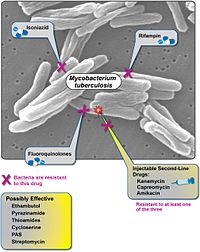
Photo from wikipedia
Background The emergence of antimicrobial resistance against Mycobacterium tuberculosis ( M. tuberculosis ) has become the major concern in global tuberculosis control due to its limited therapy options and high… Click to show full abstract
Background The emergence of antimicrobial resistance against Mycobacterium tuberculosis ( M. tuberculosis ) has become the major concern in global tuberculosis control due to its limited therapy options and high mortality. However, the clinical and molecular characteristics of drug-resistant strains vary in different geographical areas. Hainan Island located in southern China, is a high drug-resistant tuberculosis burden area. This study aimed to determine the dynamic changes of drug-resistance patterns and drug-related gene mutation types of M. tuberculosis in Hainan from 2014 to 2019. Results A total of 1484 culture-confirmed M. tuberculosis were included in this study. It was found that the proportions of drug resistance to isoniazid and rifampin were 31.3 and 31.1% respectively. Overall the proportion of multidrug resistant M. tuberculosis was 24.9%. Multivariate logistic regression analysis showed that age and the treatment history were independent influencing factors of drug resistant tuberculosis. The proportions of drug-resistant tuberculosis in retreatment patients were considerably higher than those in new patients. The most common mutation types of isoniazid were Ser315 → Thr (66.3%), and the most common mutation types of rifampin were Ser531 → Leu (41.5%). Conclusions Our data suggests that the prevalence of drug resistant TB remains high in Hainan, and the risks for developing drug resistance with diversified mutation types increased significantly in retreatment patients. These results contribute to the knowledge of the prevalence of drug resistance in Hainan Province and expand the molecular characteristics of drug resistance in China simultaneously.
Journal Title: BMC Microbiology
Year Published: 2021
Link to full text (if available)
Share on Social Media: Sign Up to like & get
recommendations!